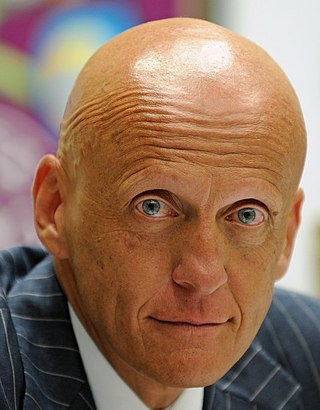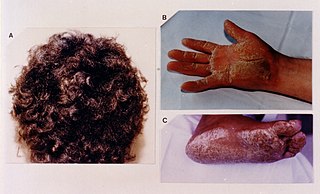
Human hair color is the pigmentation of human hair follicles due to two types of melanin: eumelanin and pheomelanin. Generally, if more melanin is present, the color of the hair is darker; if less melanin is present, the hair is lighter. The tone of the hair is dependent on the ratio of black or brown eumelanin to yellow or red pheomelanin. Levels of melanin can vary over time causing a person's hair color to change, and it is possible to have hair follicles of more than one color on the same person. Some hair colors are associated with some ethnic groups due to observed higher frequency of particular hair color within their geographical region, e.g. straight dark hair amongst East Asians, Southeast Asians, Polynesians and Native Americans, a large variety of dark, fair, curly, straight, wavy and bushy hair amongst Europeans, West Asians and North Africans, curly, dark, and uniquely helical hair with Sub Saharan Africans, whilst gray, white or "silver" hair is often associated with age.

Telogen effluvium is a scalp disorder characterized by the thinning or shedding of hair resulting from the early entry of hair in the telogen phase. It is in this phase that telogen hairs begin to shed at an increased rate, where normally the approximate rate of hair loss is 125 hairs per day.

Alopecia universalis(AU), also known as alopecia areata universalis, is a medical condition involving the loss of all body hair, including eyebrows, eyelashes, chest hair, armpit hair, and pubic hair. It is the most severe form of alopecia areata. People with the disease are usually healthy and have no other symptoms and a normal life expectancy.

Vellus hair is short, thin, light-colored, and barely noticeable hair that develops on most of a human’s body during childhood. Exceptions include the lips, the back of the ear, the palm of the hand, the sole of the foot, some external genital areas, the navel, and scar tissue. The density of hair – the number of hair follicles per area of skin – varies from person to person. Each strand of vellus hair is usually less than 2 mm long and the follicle is not connected to a sebaceous gland.

Pattern hair loss (also known as androgenetic alopecia (AGA)) is a hair loss condition that primarily affects the top and front of the scalp. In male-pattern hair loss (MPHL), the hair loss typically presents itself as either a receding front hairline, loss of hair on the crown (vertex) of the scalp, or a combination of both. Female-pattern hair loss (FPHL) typically presents as a diffuse thinning of the hair across the entire scalp.

Trichosporon is a genus of anamorphic fungi in the family Trichosporonaceae. All species of Trichosporon are yeasts with no known teleomorphs. Most are typically isolated from soil, but several species occur as a natural part of the skin microbiota of humans and other animals. Proliferation of Trichosporon yeasts in the hair can lead to an unpleasant but non-serious condition known as white piedra. Trichosporon species can also cause severe opportunistic infections (trichosporonosis) in immunocompromised individuals.
Madarosis is a condition that results in the loss of eyelashes, and sometimes eyebrows. The term "madarosis" is derived from the ancient Greek "madaros", meaning "bald". It originally was a disease of only losing eyelashes but it currently is the loss of both eyelashes and eyebrows. Eyebrows and eyelashes are both important in the prevention of bacteria and other foreign objects from entering the eye. A majority of patients with madarosis have leprosy, and it was reported that 76% of patients with varying types of leprosy had madarosis.

Piedraia hortae is a superficial fungus that exists in the soils of tropical and subtropical environments and affects both sexes of all ages. The fungus grows very slowly, forming dark hyphae, which contain chlamydoconidia cells and black colonies when grown on agar. Piedraia hortae is a dermatophyte and causes a superficial fungal infection known as black piedra, which causes the formation of black nodules on the hair shaft and leads to progressive weakening of the hair. The infection usually infects hairs on the scalp and beard, but other varieties tend to grow on pubic hairs. The infection is usually treated with cutting or shaving of the hair and followed by the application of anti-fungal and topical agents. The fungus is used for cosmetic purposes to darken hair in some societies as a symbol of attractiveness.

Microsporum audouinii is an anthropophilic fungus in the genus Microsporum. It is a type of dermatophyte that colonizes keratinized tissues causing infection. The fungus is characterized by its spindle-shaped macroconidia, clavate microconidia as well as its pitted or spiny external walls.
Anagen effluvium is the pathologic loss of anagen or growth-phase hairs. Classically, it is caused by radiation therapy to the head and systemic chemotherapy, especially with alkylating agents.

Hapalonychia, is a condition in which a toenail or fingernail nail becomes soft and thin, causing it to easily bend or break. This can result from an inherited condition, malnutrition, or debility.
Canities subita, also called Marie Antoinette syndrome or Thomas More syndrome, is an alleged condition of hair turning white overnight due to stress or trauma. The trivial names come from specific cases in history including that of Queen Marie Antoinette of France whose hair was noted as having turned stark white overnight after her capture following the ill-fated flight to Varennes during the French Revolution. An older case of Sir Thomas More's hair turning white the night before his beheading has also been recorded. Although a number of cases of rapid hair greying have been documented, the underlying patho-physiological changes have not been sufficiently studied.
Wildervanck syndrome or cervico-oculo-acoustic syndrome comprises a triad of:

Woolly hair is a difficult to brush hair, usually present since birth and typically most severe in childhood. It has extreme curls and kinks and occurs in non-black people and is distinct from Afro textured hair. The hairs come together to form tight locks, unlike in afro-textured hair, where the hairs remain individual. Woolly hair can be generalised over the whole scalp, when it tends to run in families, or it may involve just part of the scalp as in woolly hair nevus.

The dermoepidermal junction or dermal-epidermal junction (DEJ) is the interface between the epidermal and the dermal layers of the skin. The basal cells of the epidermis connect to the basement membrane by the anchoring filaments of hemidesmosomes; the cells of the papillary layer of the dermis are attached to the basement membrane by anchoring fibrils, which consist of type VII collagen.
Premature greying of hair (PGH), also known as canities, can have negative effects on appearance, self-confidence, self-esteem, and social acceptance of the affected individual. Hair is said to have greyed prematurely if it occurs before the age of 20 years in Europeans, before 25 years in Asians, and before 30 years in Africans.

Venkataram Mysore is a dermatologist, dermatopathologist, and hair transplant surgeon from Bangalore, India. He has over 30 years experience as a dermatologist, 18 years as a teacher and is currently the director of the Venkat Center for Advanced Dermatology and Post-Graduate Training.
Frictional alopecia is the loss of hair that is caused by rubbing of the hair, follicles, or skin around the follicle. The most typical example of this is the loss of ankle hair among people who wear socks constantly for years. The hair may not grow back even years after the source of friction has ended.

Hair oil is an oil-based cosmetic product intended to improve the condition of hair. Various types of oils may be included in hair oil products. These often purport to aid with hair growth, dryness, or damage.
Histopathology of dermatitis can be performed in uncertain cases of inflammatory skin condition that remain uncertain after history and physical examination.













